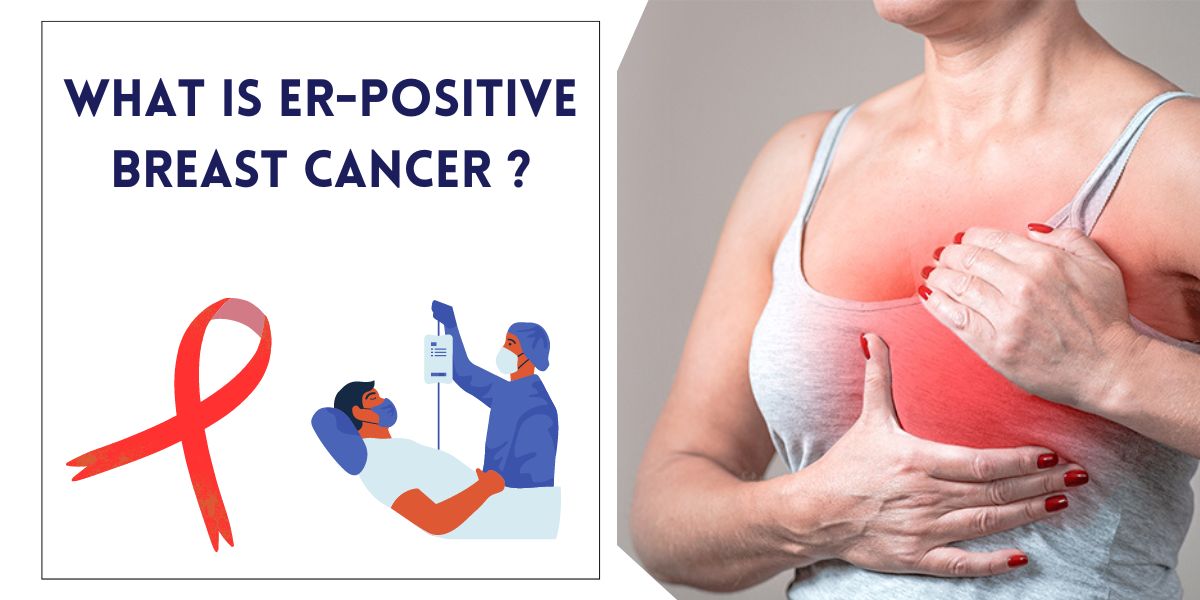BLOG
What is ER-positive Breast Cancer ?

What is ER-positive Breast Cancer ? : A Comprehensive Guide
Breast cancer is a complex and multifaceted disease that affects millions of women worldwide. Among the various subtypes of breast cancer, ER-positive breast cancer stands out as one of the most prevalent and clinically significant forms. In this article, we'll delve into what ER-positive breast cancer is, its characteristics, diagnosis, treatment options, and its impact on patients' lives.
Understanding ER-Positive Breast Cancer
ER-positive breast cancer refers to a subtype of breast cancer where the cancer cells have receptors for estrogen, a hormone that plays a crucial role in the growth and development of breast tissue. These receptors, known as estrogen receptors (ER), are proteins found both inside and on the surface of cells. When estrogen binds to these receptors, it can stimulate the growth of breast cancer cells, making ER-positive breast cancer particularly sensitive to hormonal influences.
Characteristics of ER-Positive Breast Cancer
ER-positive breast cancer tends to grow more slowly compared to other subtypes, such as triple-negative breast cancer. This characteristic is significant because it means that ER-positive breast cancer may respond well to hormone-based therapies that target estrogen receptors. However, despite its typically slower growth rate, ER-positive breast cancer can still spread to other parts of the body if left untreated.
Diagnosing ER-positive breast cancer typically involves a combination of imaging tests, such as mammograms, ultrasounds, and MRIs, along with a biopsy to confirm the presence of cancer cells and determine their hormone receptor status. If the cancer cells test positive for estrogen receptors, the tumor is classified as ER-positive.
Treatment for ER-positive breast cancer often involves a multidisciplinary approach tailored to the individual patient's needs. The primary goal of treatment is to eradicate the cancer cells, prevent recurrence, and improve overall survival. Common treatment options for ER-positive breast cancer may include:
1. Hormone Therapy
Hormone therapy, also known as endocrine therapy, is a cornerstone of treatment for ER-positive breast cancer. This approach aims to block the effects of estrogen on cancer cells or lower estrogen levels in the body, thereby inhibiting tumor growth. Common hormone therapy drugs include tamoxifen, aromatase inhibitors (such as letrozole and anastrozole), and selective estrogen receptor degraders (SERDs) like fulvestrant.
2. Chemotherapy
While ER-positive breast cancer tends to respond well to hormone therapy, chemotherapy may also be recommended in certain cases, particularly if the cancer is aggressive or has spread to nearby lymph nodes or other organs.
3. Surgery
Surgery, such as lumpectomy or mastectomy, may be performed to remove the tumor and surrounding tissue. In some cases, lymph node dissection may also be necessary to assess whether the cancer has spread to nearby lymph nodes.
4. Radiation Therapy
Radiation therapy may be used following surgery to target any remaining cancer cells and reduce the risk of recurrence. It may also be used as part of the primary treatment regimen in some cases.
5. Targeted Therapy
In addition to hormone therapy, targeted therapies that specifically target certain molecular pathways involved in cancer growth may be recommended for some patients. These targeted therapies may include drugs like trastuzumab (Herceptin) for HER2-positive breast cancer or CDK4/6 inhibitors like palbociclib and ribociclib for ER-positive, HER2-negative breast cancer.
Impact on Patients' Lives
A diagnosis of ER-positive breast cancer can have a significant impact on patients' lives, both physically and emotionally. The journey through diagnosis, treatment, and survivorship can be challenging, requiring resilience, support, and access to comprehensive care. Many patients may experience side effects from treatment, such as fatigue, nausea, hair loss, and emotional distress. However, with advancements in treatment options and supportive care services, the prognosis for ER-positive breast cancer continues to improve, offering hope for better outcomes and quality of life for patients and their families.
In conclusion
ER-positive breast cancer represents a distinct subtype of breast cancer characterized by the presence of estrogen receptors on cancer cells. Understanding the unique biological characteristics of ER-positive breast cancer is essential for guiding treatment decisions and improving patient outcomes. Through a multidisciplinary approach that combines surgery, radiation, chemotherapy, hormone therapy, and targeted therapies, healthcare providers can effectively manage ER-positive breast cancer and support patients throughout their journey towards survivorship.

